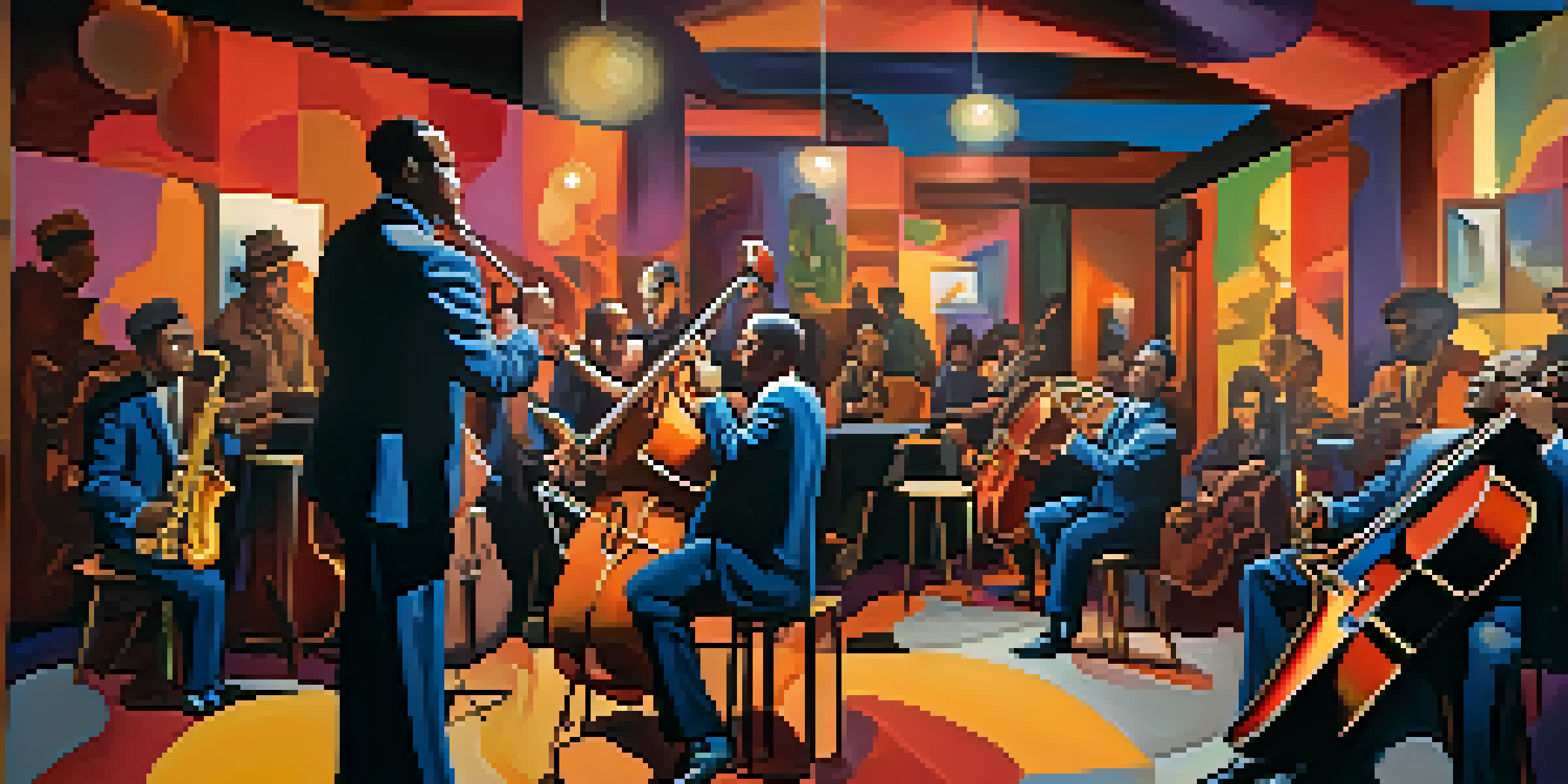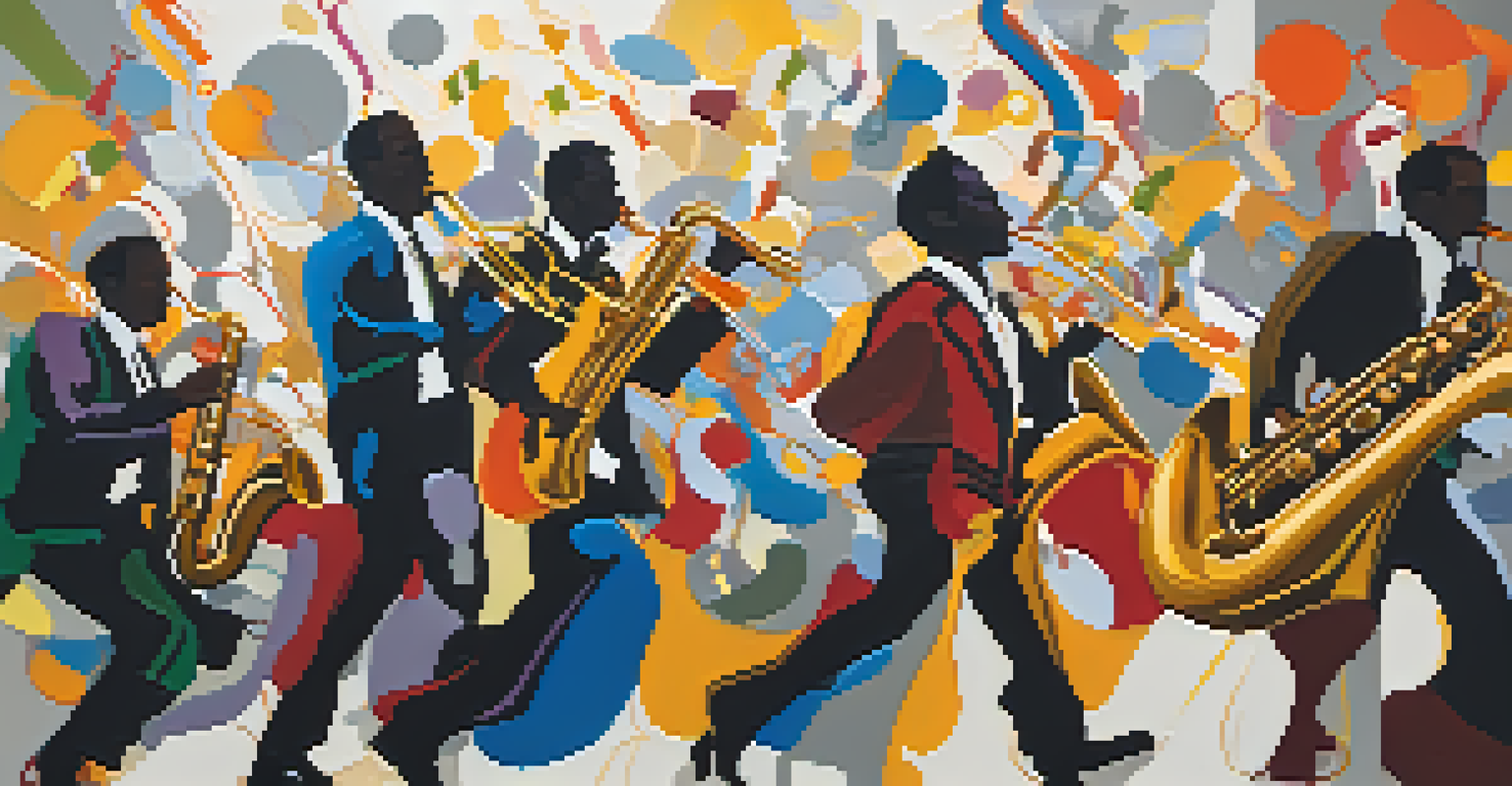The Influence of Jazz on Modern Expressionist Paintings

Exploring the Roots of Jazz and Expressionism
Jazz emerged in the early 20th century, characterized by its improvisational style and emotional depth. Similarly, expressionism in art sought to convey deep emotional experiences rather than realistic depictions. Both movements arose as a response to their respective historical contexts, reflecting the complexities of human experience during times of change.
Jazz is a music of the people, for the people, and by the people.
The syncopated rhythms of jazz paralleled the bold, energetic brushstrokes seen in expressionist paintings. Artists sought to capture the raw intensity of emotion, much like jazz musicians aimed to express feelings through sound. This connection between the two forms created a shared language of artistic expression that transcended traditional boundaries.
As jazz continued to evolve, so did its influence on visual arts, inspiring a generation of expressionist artists. The vibrancy and spontaneity of jazz rhythms resonated with painters, encouraging them to explore new techniques and styles. This symbiotic relationship laid the groundwork for a unique artistic dialogue between music and visual art.
Key Characteristics of Jazz and Expressionism
Both jazz and expressionism prioritize individual expression and spontaneity. In jazz, musicians often improvise, creating a unique performance each time, while expressionist artists embrace emotional authenticity, allowing feelings to guide their work. This focus on personal experience unites the two forms, emphasizing a departure from traditional norms.

The use of color in expressionism can be likened to the use of sound in jazz. Just as musicians select notes and tones to evoke specific emotions, expressionist painters use vibrant colors and bold contrasts to capture feelings. This parallel highlights how both art forms aim to communicate complex emotional landscapes.
Jazz and Expressionism's Emotional Depth
Both jazz and expressionism aim to convey deep emotional experiences, using improvisation and vibrant colors to reflect the complexities of human feelings.
Moreover, the influence of jazz can be seen in the movement's rhythm and composition. Expressionist artists often apply dynamic brushwork that mirrors the fluidity and improvisational nature of jazz music. This interplay creates an engaging experience for the viewer, akin to the way a jazz performance captivates its audience.
Notable Artists Inspired by Jazz
Many renowned expressionist artists found inspiration in jazz music. For instance, Wassily Kandinsky, known for his abstract works, was influenced by the rhythms and improvisational qualities of jazz. His use of color and form often reflects the dynamic energy found in jazz, creating a visual symphony that resonates with viewers.
Art is the most beautiful of all lies; it is the lie that makes us see the truth.
Another key figure, Jean-Michel Basquiat, fused elements of jazz into his powerful street art and expressionist paintings. His works often incorporate themes of spontaneity and rhythm, drawing parallels to the improvisational nature of jazz. Basquiat's art serves as a testament to the enduring influence of jazz across different artistic mediums.
Even contemporary artists continue to draw from jazz, with figures like Julie Mehretu using layered compositions that echo the complexity of jazz improvisation. By weaving together various influences, these artists create rich, textured works that invite viewers to experience the rhythm of both music and visual art.
The Role of Improvisation in Art and Jazz
Improvisation is a fundamental element in both jazz and expressionism, fostering creativity and spontaneity. Jazz musicians often create music on the spot, responding to the mood and energy of their fellow musicians. Similarly, expressionist artists may alter their approach mid-creation, allowing their emotions to dictate their artistic choices.
This fluidity in both forms allows for a genuine expression of the artist's inner world. In jazz, this might manifest as an unexpected melody or a sudden shift in tempo. In expressionist painting, it could be an unplanned splash of color or a spontaneous change in composition, both reflecting the artist's immediate feelings and thoughts.
Influence of Jazz on Visual Artists
Jazz has inspired many expressionist artists, encouraging them to explore new techniques and create visually dynamic works that resonate with the spontaneity of music.
The unpredictable nature of improvisation enhances the connection between artists and their audiences. Just as a jazz performance can evoke powerful emotions through spontaneous moments, expressionist art invites viewers to engage with the artist's emotional journey. This shared experience enriches the appreciation of both art forms.
The Emotional Impact of Jazz on Visual Art
Jazz music's ability to evoke strong emotions parallels the impact of expressionist paintings on viewers. The improvisational nature of jazz can stir feelings of joy, melancholy, or nostalgia, much like how a powerful expressionist piece can resonate with personal experiences. This emotional connection serves as a bridge between the two art forms.
Artists often aim to translate the emotional intensity of jazz into their paintings, using bold colors and dramatic forms to capture the essence of the music. For example, a lively jazz piece might inspire a vibrant canvas filled with dynamic shapes and contrasting hues. This interplay highlights the ability of both art forms to convey complex emotional narratives.
Additionally, jazz can influence the viewer's perception of a painting. Listening to jazz while viewing expressionist art can deepen the emotional experience, as the music complements the visual elements. This multisensory approach enriches the understanding of both the painting and the music, creating a holistic artistic experience.
Jazz as a Cultural Movement: A Broader Perspective
Jazz music has always been more than just a genre; it represents a cultural movement that challenged societal norms. Similarly, expressionism emerged as a reaction to traditional artistic conventions, advocating for individualism and emotional authenticity. This shared ethos between jazz and expressionism underscores their cultural significance.
The influence of jazz extends beyond the canvas, inspiring social change and artistic revolutions. Just as jazz musicians broke barriers in the music industry, expressionist artists defied traditional artistic boundaries. This parallel illustrates how both movements were instrumental in shaping modern art and culture.
Cultural Movements of Jazz and Art
Jazz and expressionism represent cultural movements that challenge societal norms, advocating for individualism and emotional authenticity in their respective fields.
Through their respective journeys, jazz and expressionism have forged connections among diverse communities, fostering a sense of belonging and shared experience. This cultural dialogue continues to inspire new generations of artists, allowing the legacy of jazz to thrive within the realm of visual art.
The Future of Jazz and Expressionism
As we look to the future, the relationship between jazz and expressionism remains vibrant and evolving. Contemporary artists continue to explore this connection, experimenting with new mediums and techniques that blend visual art and music. This ongoing dialogue ensures that both art forms will continue to inspire one another.
Emerging technologies also play a role in shaping the future of this artistic relationship. Digital art and multimedia installations allow artists to incorporate elements of jazz in innovative ways, creating immersive experiences that engage audiences on multiple levels. This fusion of art forms opens up exciting possibilities for collaboration and creative expression.

Ultimately, the influence of jazz on modern expressionist paintings serves as a reminder of the power of artistic expression. As artists draw from the rich history of jazz, they contribute to a dynamic cultural landscape that celebrates creativity, emotion, and the human experience. This interplay between music and visual art will undoubtedly continue to resonate for years to come.